Remembering "the Bird"
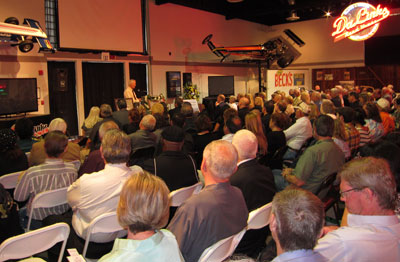 |
Last Thursday, a strong turnout of the NHRA family came together at the Wally Parks NHRA Motorsports Museum presented by Automobile Club of Southern California to honor our longtime friend Bernie Partridge, who died a week earlier after a prolonged illness. What already was a rough month with the passing of Pro Stock icon Bill “Grumpy” Jenkins became triply tough as Bernie died just a day after the unexpected passing of his son, John, who had a heart attack. The family – with Bernie and strong-willed wife P.J. at the helm – which I regard as one of the first families of the NHRA, has had more than its share of losses with the passing as well of Bernie and P.J.’s second son, Gary, last summer.
Bernie suffered a stroke in 1999 that impaired his speech, a cruel twist of fate for the guy widely known as the first “voice of the NHRA,” our chief announcer from 1958 well into the 1980s. In many ways, the gathering at the museum was as much to celebrate Bernie’s life as it was to support and show our love for the family – P.J. and their two remaining sons, Bernie Jr. and Jim – and that was evident from the long line of speakers who not only heaped praise on Bernie but also P.J. for her tireless and selfless efforts to make the last dozen years as good as they could be for her husband.
Former Funny Car driver and NHRA Safety Safari presented by AAA leader Leroy “Doc” Hales presided over the memorial and looked out to a room that was packed with NHRA employees present and past, including many from the Division 7 group, among them former Tech Director Cloy Fitzgerald. All of NHRA’s current management group, including board chairman Dallas Gardner and President Tom Compton, were on hand. The star quotient was high, as Don “the Snake” Prudhomme, Tom “the Mongoose” McEwen, John Force, and Roland Leong came to pay their respects, as did former Division 7 track owners and managers Bill Doner, Charlie Allen, Glenn Menard, and Allan Miller and longtime Division 7 alcohol racers Jay Payne and Don Irvin.
At Hales’ urging, the day was to celebrate Bernie’s memory with fun stories because “That’s the way Bernie was, and that’s the way we want to remember him.”
During the next 90 minutes, a variety of speakers took to the podium to share their memories of “the Bird,” to make good-natured fun of his microphone miscues, his poor sense of direction, and his penchant for speaking his mind and to laud his personality and dedication to the NHRA cause. “His job was also his passion,” said Hales. “He was a talkative guy. Bernie never met a stranger; from the time he first met you, he’d talk to you and act like he knew you forever.”
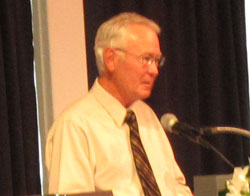 |
Gardner, who as NHRA president in the 1980s and 1990s worked closely and traveled often with Partridge, was effusive in his praise.
“When you look back at the history of NHRA, Bernie Partridge was one of the guys who really counted. He put his mark on the sport, and it wasn’t from behind the microphone. When NHRA was just getting organized, it was like, 'The plane’s off the ground, just barely ... hell, what do we do with it now? How do we move it forward?' [Wally Parks] needed people he could rely on that shared his vision, which led to the first division directors. What Bernie brought to the party was that he was a racer, an honest racer, he ran racetracks, he knew about the parts and pieces and knew about the sport from the ground up. The formation of those division directors was really the foundation of the next step in drag racing to step up and be accepted nationally at least. He not only needed to talk the gospel but be able to talk to the people who would build the racetracks, get involved, endorse it, and that was a tough thing to do, but that’s what Bernie did best. The sport would not be where it is today without Bernie Partridge.”
Gardner also related a funny story about golfing with Partridge and NHRA founder Wally Parks at the annual Winston golf tournament at the course adjacent to the Pomona racetrack.
“Bernie wasn’t a very good golfer,” he prefaced the story. “So we come to one hole, and we’re ready to tee off, and just off the course, about 45 degrees, were some course workers. Bernie puts the ball down and some of them move, but there’s this one big guy still standing there. Bernie clocked this ball solid, and it went 45 degrees and hit this big guy right in the [private parts]. This guy is rolling on the ground, and there’s Bernie, with his cigar hanging out of his mouth; I think he almost swallowed it. Wally’s already in the golf cart trying to get away, and Bernie looks at me and says, ‘Do I need another ball or can I play that one?’ We never played golf with Bernie again.”

This cool photo was on display. It shows Bernie Partridge, far right, with NHRA's management team of the early 1980s. From left are Carl Olson, Steve Gibbs, Dallas Gardner, Wally Parks, and Brian Tracy. These are the guys who were calling the shots when I came to work for NHRA in 1982.
|
Steve Gibbs, NHRA’s longtime competition director and vice president, met Partridge when he was the manager of Irwindale Raceway in the 1960s and through him was introduced to Parks and the man who would become his mentor, Jack Hart. Gibbs echoed some of Gardner’s statements about Partridge’s dedication and at the end put that whole early era into a touching context.
“Bernie was a true believer; he was a disciple and was out there doing what he did at a time when it wasn’t very easy to do it, but he helped make the sport into something out of nothing,” said Gibbs. “It’s amazing how many people out there today are making their living in drag racing who aren’t even aware of people like Bernie and Jack Hart and Wally and Barbara Parks and Bob Daniels. They’re the pioneers of the sport who got us to where we are today, and Bernie was right at the head of the class.”
Gibbs then referenced newsman Tom Brokaw’s book The Greatest Generation, which salutes American citizens who came of age during the Great Depression and the second World War and went on to build modern America. “I think that group of people from the ‘50s and ‘60s, I think they qualify for drag racing’s ‘greatest generation.’ They took what was basically an outlaw sport and turned it into a major international motorsport that it is today. We just can’t forget those people.”
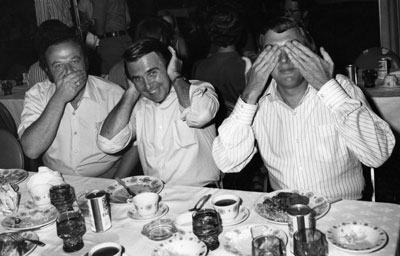
Here's a pretty memorable shot of Dave McClelland, Partridge, and Steve Evans doing the whole "Speak no evil, hear no evil, see no evil" monkeys routine.
|
Dave McClelland, who with Partridge and the late Steve Evans formed a dynamic trio of NHRA national event announcers in the 1970s, also spoke about Partridge’s effect on his career, beginning with his first big gig at the 1961 Nationals in Indy. He remembered him as “a mentor and a friend who made possible my career in announcing and beyond.”
McClelland also dragged out some of Partridge’s familiar favorite phrases – “He was very attached to them," he recalled slyly – such as “The race is at hand” and “drunk with horsepower” and “thunder in the pipes.” (Earlier, someone in the audience had shouted out one of Partridge’s infamous mixed metaphors: “There’s no sense in beating your head against a dead horse.”)
Anyone who attended NHRA races in the 1970s through the mid-1980s probably heard Partridge’s most well-used phrase, usually offered mid-sentence to correct himself: “Check that!”
McClelland then referenced the brilliant gag Christmas gift bestowed upon Partridge at one of NHRA’s notoriously un-PC holiday parties from the 1970s/early 1980s. Although McClelland didn’t cite the prankster – National DRAGSTER’s own George Phillips – he did recall the fake album cover that was a sort-of "Bernie Partridge’s greatest misses," with song titles of some of his memorable malaprops. The album, The Bird Sings, featured the not-hit-single “Check that thing baby!" I think that was 1982, my first year with NHRA, and I’ve never forgotten it. I remember seeing a note from P.J. to George, telling him that his work was “low e.t. of the event,” which I thought was an interesting and unforgettable way of lavishing praise among us drag racing types.
 |
No one shared any of those great miscues, but I do have one that I’ll share here. Although I did not hear it myself, it’s been a favorite chestnut of the DRAGSTER staff for decades. Now, I can’t swear to its accuracy (or even its truth), but it’ll get you in the spirit. As the story goes, it was between Pro qualifying sessions one year at the World Finals at Orange County Int’l Raceway, and legendary Top Fuel racer Connie Kalitta was on the return road at around half-track, looking over the race course, when suddenly, over the PA, here comes Bernie: “OK, ladies and gentlemen, coming around the bend from the staging lanes, here they are, the kings of the sport, Top Fuel dragsters!”
Caught unawares that his class was taking center stage, Kalitta goes running back up the return road – comb and change falling out of his pockets – and he gets almost back to the starting line, sweat pouring down his face, before Partridge comes back on the mike and says, “Check that: These are the alcohol dragsters,” sending Kalitta into an obscenity-laced commentary about Partridge’s abilities.
“Bernie may not have been the greatest announcer from a technical standpoint, but he had more enthusiasm and more dedication for what we were about,” said Gibbs. “He loved what we were doing, and it showed. He was the best.”
David Leighton, who worked with his father, Gus, and Bernie – Dust Devils Auto Club alumni all -- to set up impromptu tracks across Division 7, mostly on airport runways with short notice, noted Partridge’s tireless efforts and joked, “We opened and closed more racetracks than Steve Evans did.” Leighton also marveled at Partridge’s ability to verbally paint a picture of what was going on at the track, comparing him to baseball announcing great Vin Scully.
Partridge gave a lot of folks their first work at NHRA, including current NHRA Senior Vice President Graham Light – whom Partridge hired in 1984 as a division director – and Cindy Gibbs, whose first paying job was as a spotter in the tower at Ontario Motor Speedway and who later went to work in the Division 7 Field Office. “I thought I had died and gone to heaven. All I ever wanted to do was work in drag racing,” she said in thanking Partridge.
Phillips shared Partridge’s secret method for the shrewd manipulation of meetings and how to get out of a meeting what he needed and Partridge’s love for sailing. Menard, who managed Irwindale in 1972 when there was fierce competition between Irwindale, Lions, and OCIR, remembered how Partridge took him deep-sea fishing with Evans, who was managing Lions, and OCIR’s Mike Jones to give them a chance to bond and be more than just rivals.
 |
Force related a story about his first meeting with the Partridges, at the gates of a Division 7 event.
“I was trying to get into the racetrack, and I was making a lot of noise,” he remembered. “This man – I didn’t really know who it was, but it was Bernie – called me over and said, ‘Son, you’re making a lot of noise. What is the problem?’ I said, ‘They won’t let my race team in. Those ladies over in that [racer registration] trailer; I’m trying to give them my money, and they won’t let me in, and I don’t understand that.’ He said, ‘Well, what are you telling them?’ and I said, ‘Well, there’s this one lady [P.J., as it turns out], I tell her that someday I’m going to be somebody, a racer, a driver. But that one lady, she’s not buying it.’
“And he said to me, ‘Let’s talk the truth. What is the real problem?’ So I told him that I had a team, and that they all work for free, and I don’t have enough money to pay for all of us to get in. He said, ‘Do you have nitro?’ and I said, ‘No; I’ll get that inside the track.’ He said, 'Do you have tires?’ and I said, ‘I’ll get tires …’ He said, ‘You got a motor?’ and I said,’ Almost …’
“I was wondering, ‘Why is this guy talking me to death? I don’t even know this fella.’ And he said to me, ‘Why do you want to do this?’ I said, ‘Because I really love it, and I’m going to be Don Prudhomme someday,’ and he said, ‘Really?’ and then he asked, ‘You really love it? OK, I’m going to get you those tickets; I’m going to get you in.’ He asked me my name, and I told him, and he said, ‘OK, John Force, you tell the truth.’ I said, ‘I always tell the truth; I just embellish it some.’ He said, ‘Listen to me: Tell the truth,’ and I’ve always thought of that, and even to this day, I’m still trying to be Don Prudhomme, but I swear to God, Bernie, I try to tell the truth. In my life, there have been a lot of people who have changed me, some for better, some for worse, but that two-minute conversation changed my life."
Linda Vaughn shared a story about how Bernie encouraged the “nervous wreck” of a young girl from Dalton, Ga., in her debut as Miss Hurst Golden Shifter at the 1966 Winternationals. He told me, ‘I’m going to take care of you because I’m the announcer,’ and he was wonderful. He was the very first one to get me going, and I just fell in love with it.”
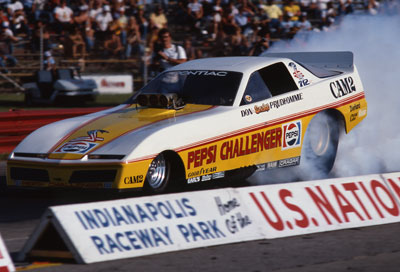 |
Prudhomme closed the remembrances by reasserting his allegiance to his home Division 7, which Partridge led for so many years. “I’m a Division 7 guy, and my number was 712, and I wore it proudly,” he said. “After losing the championship to Raymond Beadle, I was supposed to put a 2 on the car, but I said, ‘Screw that; I’m going to put 712 back on the car.’
"One of the reasons we respected Bernie was that, even though Wally was the man, Bernie pretty much ran the show. If you needed something, you went to Bernie. He was a helluva guy, and I was proud to be part of Division 7.”
I think we’ve always been proud to be part of that family, and last week’s turnout only reinforced that. There’s an especially tight bond among those who lived those formative early days and helped us through them by leading the way. As Gibbs said, we should never forget them. I know I won’t.

 |
Here’s today's disclaimer about upcoming Insider columns. As you can see from the app on my phone, it has been a busy month, and the next two weeks are going to be a bit hellish, with the Houston and Atlanta events on back-to-back weekends. I leave Thursday for Houston, return Monday, then leave again three days later for Atlanta. Those short two full days in the office are going to be jam-packed with my usual National DRAGSTER work, so there’s no way I’ll be writing a column in the next 10 days or so. Sorry ’bout that. I know from your emails that many of you look forward to our twice-weekly get-togethers, and it pains me to think I’m letting any of you down because you’ve been so great and loyal.
As you also can see on the screenshot, I have a decent break after Atlanta, but – fair warning -- I travel quite a bit this summer. I’ll of course do everything I can to continue to offer you fun and interesting reading. I have quite a few column ideas in the works that I’ll be piecing together as time allows. The next original column will be a follow-up to the Garlits Swamp Rat XXX tale as I recount the “blowover years.” I think I’ve been able to document every Top Fuel blowover from the 1980s and 1990s (and a few beyond that), and we’ll take a look at that phenomenon. If you have any blowover photos to share, please pass them along.
The second part of my sob story involves yet another move. Some of you may remember that it wasn't all that long ago -- December 2010 -- that the National DRAGSTER editorial staff packed up its meager belongings and moved from upstairs to downstairs at Publishing HQ on famous and fabulous Route 66 to consolidate with the rest of the departments on the first floor.
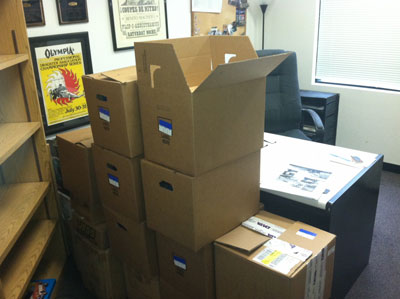 |
Well, here I am, less than a year and a half later, doing it all over again as the entire Publications Department prepares to move back in with the headquarters staff on Financial Way. This will mark my fourth move, which I guess isn't bad for nearly 30 years on the job. I was at the North Hollywood headquarters on Riverside Drive from my hiring in 1982 until we all moved east to Glendora in early 1987. In 1993, the Publications group leased this spot on Route 66, just a quarter-mile or so from HQ. And now, after 19 years out on our own, we're being reunited with the Mother Ship beginning Thursday.
The bummers this time, however, are twofold. First, when we moved in 2010, I was digging through boxes of stuff that I hadn't seen since the 1993 move, which made for some fun columns (here and here) as I found a bunch of cool little treasures. No such fun this time, as it's all-too-familiar stuff. Second, if you were paying attention a few paragraphs ago, you'll see that Thursday is when I'm headed to Houston, so a) I have to be all packed up by Wednesday, and b) when I get back Monday, I'm going to walk into a new office that's packed with boxes (17 so far, probably headed to 20) that will require unpacking before I get back up to speed.





















































